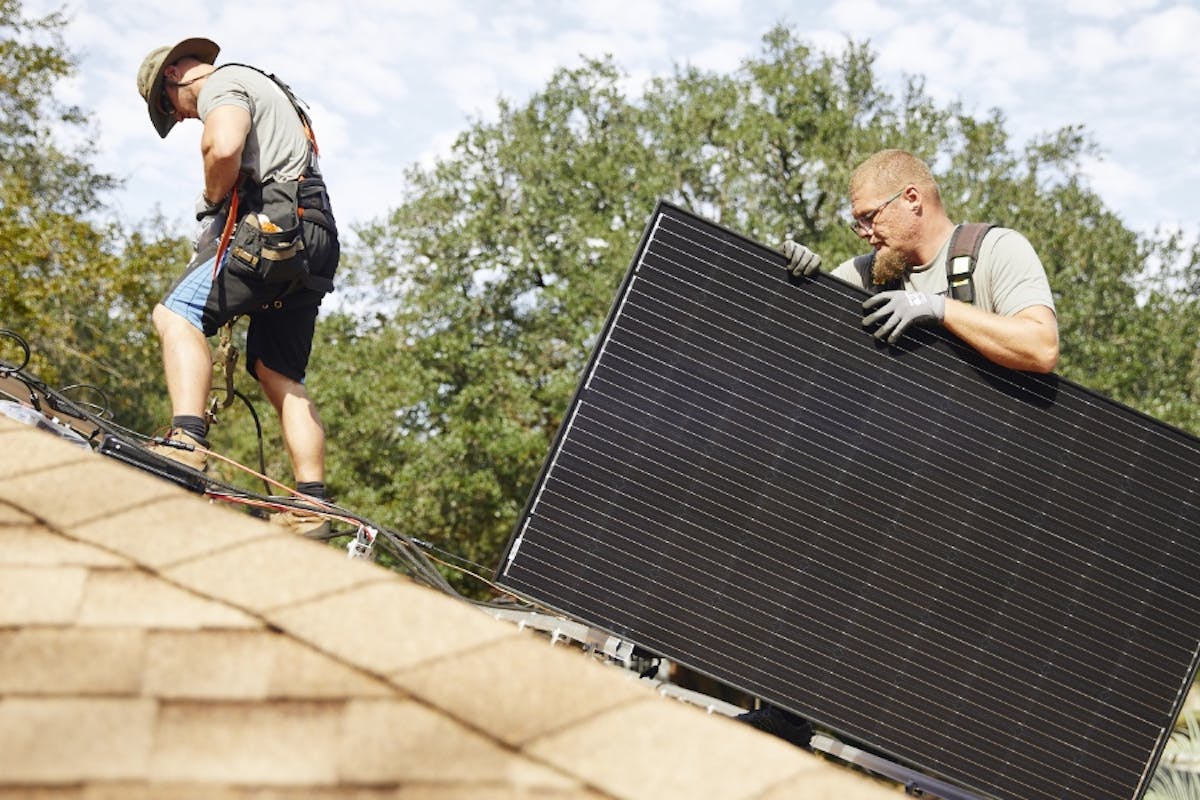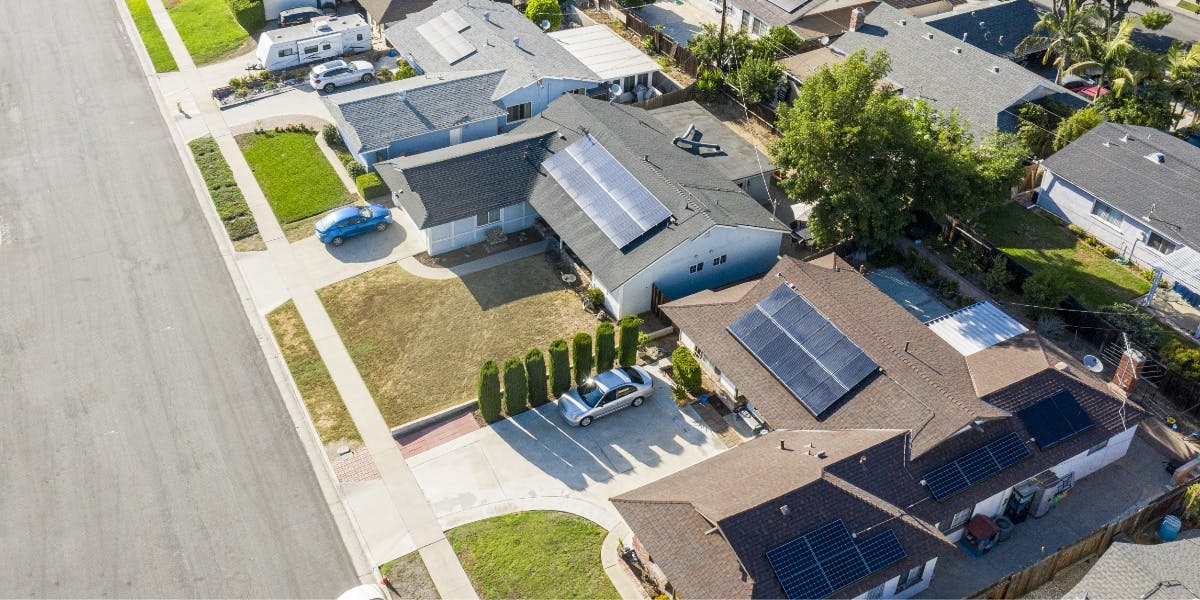Is My Roof Big Enough for Solar Panels?
Last edited

Author
Andrew Giermak
Solar and Electrification Writer and Editor

Editor
Andrew Blok
Electrification and Solar Writer and Editor

Thinking about home solar panels? The most common location for them is the roof.
Putting panels on roofs is great for a lot of reasons: They don't take up yard space and get plenty of sunlight to start. But how do you know you've got enough roof space for solar panels?
A solar company can always tell you, but you can also get an idea on your own. Here's how.
See how much you can save by going solar with Palmetto
How Many Solar Panels Can Fit on My Roof?
There are a few rules of thumb that can give you a general idea how much roof space is needed for solar panels. These guidelines can also help determine how much roof space you have available for solar panel installation.
Generally, every square foot of roof space has the potential to generate about 15 watts of solar energy. Thus, a solar panel installation on a small home might need about 200 square feet of roof space, while a larger home can require more than 1,000 square feet of roof space to properly offset its electricity usage.
To offset an average amount of energy usage by the average American home, you’ll typically need 18-24 panels. That is, of course, if the panels are of a standard rating, their positioning is optimal, and the location gets adequate sunlight year-round. If you change any of those variables, the number of panels you need in your array is going to change as well.
If you want to get a sense of how many panels a roof can support, you don't need a fancy solar panel square footage calculator. Here’s an easy calculation you can do.
Multiply the square footage of your roof by .75 to account for the required solar setback. (More on that below.) Take that number and divide it by 17.5, which is the average square footage of the standard solar panel size. The resulting number is the maximum number of solar panels you can fit on your home’s roof.

How Much Power Can My Roof Generate?
Let’s take a 24-panel solar array using 400-watt panels as an example. Pretty simple math here is 24 multiplied by 400 to total 9,600 watts.
A solar array's capacity is measured in watts. The electricity produced is measured in watt-hours or, more commonly, in kilowatt-hours (kWh). If a solar panel produces 400W of electricity for one hour, it is producing 400 watt-hours, or 0.4 kWh. So 24 panels, with ideal power-generating conditions, could produce 9.6 kWh in an hour.
Learn more about solar panel output with more detailed math and examples or use the National Renewable Energy Laboratory’s PVWatts Calculator to learn more.
How Close Can Solar Panels Be to the Edge of the Roof?
Most roof-mounted solar installations will need a “solar panel setback” for safety. This is one of the most common requirements for roof solar panels in local and state building codes. This setback is the open space between the edge of the solar array and the edge of the roof, and it provides an unobstructed pathway around your rooftop for emergency responders like firefighters to get better access to your home in case of an emergency.
The minimum solar panel setback varies from state to state, but generally, the setback will take up about 25 percent of your roof’s usable space. This accounts for two roughly 36-inch wide pathways that run along the edge of your roof, on a roof with just two basic faces. If your roof is more complicated than that, with multiple faces or odd angles, your setback requirements may be different, which is why it’s important to work with solar professionals.
Factors to Determine How Many Solar Panels You Need
When determining how many solar panels you need, it’s important to start with your goals and why you want to go solar in the first place.
Do you want to maximize your return on investment?
Do you want to save as much money as possible?
Do you want to reduce your upfront costs?
Do you want to reduce your carbon footprint as much as possible?
Once you have your goals in mind, you can determine how many solar panels you need to get there. This calculation is going to depend on how much energy your family uses, your roof area and specifications, your home’s location, how much sunlight shines in your part of the country, the efficiency of the solar panels you’re using, and if your local utility offers net metering. Plus, you need to consider your budget, because a large solar power system might produce more energy, but the initial installation is going to cost more.
Here are a few things you should think about when determining how many solar panels you need for your roof.
Energy usage
How many solar panels (and how much roof space) you’ll need starts with an estimate of how much power your family uses in a given year. There are plenty of ways to determine your annual energy usage, but the easiest is to take a look at your monthly energy bills over a year. That will tell you how many kilowatt-hours of energy you used in a year. If you don’t know your own estimated energy usage, a good starting number is the average American home uses about 855 kWh of energy every year, though that includes homes with solar panels, so your consumption may be higher.
You should also consider potential changes to your family’s energy usage in the future. For example, if you buy a new electric vehicle, start working from home more often, or expand your family with a new child, your energy needs might change pretty significantly.
See how much you can save by going solar with Palmetto
Location
Different parts of the US get different amounts of sunlight. For instance, Juneau, Alaska gets 85 days of significant sunny conditions a year according to NOAA data. Yuma, Arizona gets 313 sunny days a year. The average across the US is 205 sunny days.
If you live somewhere with lots of sun, you might need fewer solar panels. But if you live in Juneau, you’ll need more solar panels to generate a similar amount of energy.
The direction of your roof also determines how many solar panels you need. In the northern hemisphere, southern-facing roofs are ideal, as they receive more direct sunlight and can use that sunlight to create more energy. If your roof does not face south, you may need either a more complicated installation to get your panels facing the right direction or more panels to make up for the difference in energy-creating potential.

Size and rating of your solar panels
Solar panels vary in efficiency. More efficient panels may be able to squeeze more energy out of a smaller space. If you have the space for them, less efficient panels could meet your goals for less money.
While the efficiency of solar panels might vary, solar panel sizes typically don’t, as most companies have a standard solar panel square footage to make installation easier. The standard solar panel size dimensions are about 65 inches by 39 inches, which is roughly 17.5 square feet.
Your budget
Generally, larger systems are a great way to quickly offset your current electrical usage. However, larger systems are naturally more expensive. While you may have the roof real estate for a large array, you might not have the financial budget for it, and vice versa.
Another thing to consider when figuring out your budget is whether your local utility offers net metering, and what rate they offer for that net metering. If you’re not familiar, net metering is when your utility company offers you credits for the extra energy your system produces and feeds back into the grid. These credits can be used to offset the cost of power you might use from the grid, such as at night or during storms if you don’t have a battery storage system. If your local utility offers a generous net metering policy, it may allow you to expand your initial budget and then make up that difference over time. Net metering often comes with restrictions on how large of a system you can install.
Is it Possible to Install Too Many Solar Panels?
Believe it or not, it’s not always beneficial to install as many solar panels as you can possibly fit on your roof. An oversized system may be more expensive without returning addition savings.
A good solar installation should offset as close to the exact amount of energy that you use as possible. That’s why installers ask for samples of previous power bills: to design a system that meets your actual needs. Some months you might use more energy than your system produces, and some months you might use less energy than you produce, but at the end of the year, the goal is to generate about the same amount of energy as you use.
That said, there are some instances where it makes sense to install more solar panels to generate more energy than you plan on using. The first is if you plan on installing an energy storage system to capture that excess energy. Solar battery storage lets you use the energy you generated during the day to power your home at night, and also gives you a backup source of power in case you have a blackout or other issue.
Another time you might want to generate more power than you plan to use is if your utility offers a strong net metering benefit.
How to Put Solar Panels on Your Roof
Your home’s roof space is just one of the factors that determine the optimum solar power system for your family’s needs. The arrangement of panels and the difficulty of the installation are determined by your roof, but you also need to consider your family’s energy needs, any future changes your family might expect, your local incentives and net-metering programs, and other individualized factors.
Palmetto can help figure out the precise number and type of panels that will work best for your roof and your family’s needs.To find out how many panels you can put on your roof, get started with a free solar estimate or contact a solar advisor today
See what solar can do for you:
Frequently Asked Questions
What if my roof is too small for solar panels?
If your roof is too small, high-efficiency panels or ground-mounted panels may be a better fit.
Are rooftop solar panels a good fit for everyone?
No, while solar technology is becoming a better fit for more homeowners and steadily becoming more affordable, there are circumstances when home solar panels aren’t the right choice. A home with low energy bills or an incompatible roof design or material may not be a good fit.


